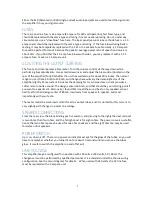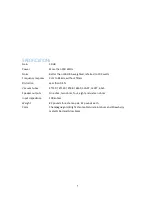
1
CIRCUIT DESCRIPTION
The input stage consists of a 12AX7 current sourced long-tailed balanced pair, which is direct
coupled to a second long-tailed balanced pair comprised of a 12AT7. The 12AT7 drives the grids of
the KT150/KT120 output tubes through a pair of coupling capacitors that provide low frequency
loop-gain stability. A 6AL5 DC restorer ensures that the bias voltage remains correct over the
entire audio signal cycle.
The output tubes are arranged in push-pull parallel, three up, three down for a total of six in all.
The screen grids are operated at approximately 360 volts provided by a separate power supply
formed by one-half of a voltage doubler supplying the plates with 720 volts.
The power supply consists of a large power transformer, with energy storage that is far greater
than necessary. AC filament voltage is biased to approximately 60 volts. Multiple decoupling filter
sections are used with load regulation obtained through constant current loading.
Turn-on in-rush current limiting is provided by a thermistor, bias voltage adjustment by a bias
control, feedback gain by a top-mounted front panel switch, volume by a volume control, and bias
voltage is measured across a one ohm sense resistor that senses current for all six output tubes
simultaneously. A tube fuse is mounted on the rear apron and provides protection for the output
section in the event of a catastrophic vacuum tube failure. Additionally, a rear mounted power
line fuse provides overall protection for the amplifier.
VACUUM TUBES
The output tubes do not need to be matched, as the sound of the amp does not at all depend on
matched output tubes. That's because the DC restorer circuit eliminates the need to match tubes.
The only caveat here is that the output tubes should all be the same type and vintage.
Looking at the amplifier from the front, from left to right: the first tube is a 12AX7, then a 12AT7,
and finally the 6AL5. The output tubes are KT120's. Any of the popular derivatives such as '88, '90,
or '100 may also be installed. The mighty 6550 may be used as well, even the ubiquitous EL34.
However, performance will suffer a bit with the EL34 because the design has been optimized for
the KT88 / KT120 / 6550.
FEEDBACK SWITCH
The small switch mounted on the top front of the chassis controls the amount of negative
feedback used. When the toggle handle is pushed LEFT (classic), the feedback is approximately 20
dB, a value used by almost all vintage amplifier designers and is my personal preference. When
toggled RIGHT (contemporary), feedback is limited to about 11 dB. This represents the practice of
many modern day designers. Please try it both ways and make your own determination based on
your listening experience and your speakers.
VOLUME CONTROL
Under normal circumstances, this control should remain in the maximum (fully clockwise)
position. If you have a noisy preamp, turning it halfway down and centering it at the 12:00 o'clock
position will reduce the preamp noise by half, or 6 dB. It should always be turned all the way down
(fully counterclockwise) when connecting or disconnecting any input or output in your system.






